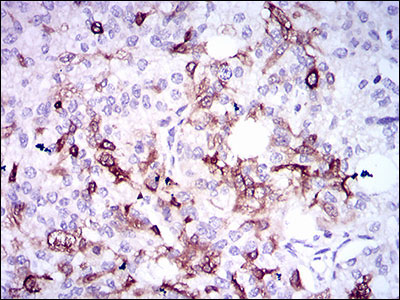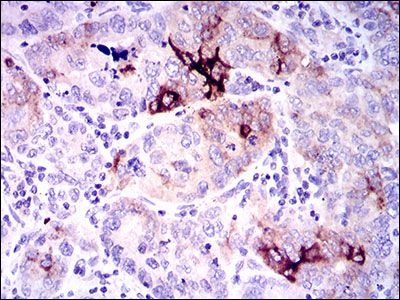SPP1 Antibody
Purified Mouse Monoclonal Antibody
- 产品详情
- 实验流程
- 背景知识
Application
| WB, IHC, ICC, E |
|---|---|
| Primary Accession | P10451 |
| Reactivity | Human |
| Host | Mouse |
| Clonality | Monoclonal |
| Clone Names | 7C5H12 |
| Isotype | IgG1 |
| Calculated MW | 35423 Da |
| Description | The protein encoded by this gene is involved in the attachment of osteoclasts to the mineralized bone matrix. The encoded protein is secreted and binds hydroxyapatite with high affinity. The osteoclast vitronectin receptor is found in the cell membrane and may be involved in the binding to this protein. This protein is also a cytokine that upregulates expression of interferon-gamma and interleukin-12. Several transcript variants encoding different isoforms have been found for this gene. |
| Immunogen | Purified recombinant fragment of human SPP1 (AA: 167-314) expressed in E. Coli. |
| Formulation | Purified antibody in PBS with 0.05% sodium azide |
| Gene ID | 6696 |
|---|---|
| Other Names | Osteopontin, Bone sialoprotein 1, Nephropontin, Secreted phosphoprotein 1, SPP-1, Urinary stone protein, Uropontin, SPP1, BNSP, OPN |
| Dilution | WB~~1/500 - 1/2000 IHC~~1/200 - 1/1000 ICC~~N/A E~~1/10000 |
| Storage | Maintain refrigerated at 2-8°C for up to 6 months. For long term storage store at -20°C in small aliquots to prevent freeze-thaw cycles. |
| Precautions | SPP1 Antibody is for research use only and not for use in diagnostic or therapeutic procedures. |
| Name | SPP1 |
|---|---|
| Synonyms | BNSP, OPN |
| Function | Major non-collagenous bone protein that binds tightly to hydroxyapatite. Appears to form an integral part of the mineralized matrix. Probably important to cell-matrix interaction. |
| Cellular Location | Secreted |
| Tissue Location | Detected in cerebrospinal fluid and urine (at protein level) (PubMed:25326458, PubMed:36213313, PubMed:37453717) Bone. Found in plasma. |
For Research Use Only. Not For Use In Diagnostic Procedures.
Provided below are standard protocols that you may find useful for product applications.
BACKGROUND
This protein encoded by this gene belongs to the WD repeat-containing family of proteins, which function in the formation of protein-protein complexes in a variety of biological pathways. This family member appears to function in the determination of mean platelet volume (MPV), and polymorphisms in this gene have been associated with variance in MPV. Alternative splicing of this gene results in multiple transcript variants. ;
REFERENCES
1.Blood. 2012 May 31;119(22):5215-20. 2.J Cancer Res Ther. 2011 Apr-Jun;7(2):138-42.
终于等到您。ABCEPTA(百远生物)抗体产品。
点击下方“我要评价 ”按钮提交您的反馈信息,您的反馈和评价是我们最宝贵的财富之一,
我们将在1-3个工作日内处理您的反馈信息。
如有疑问,联系:0512-88856768 tech-china@abcepta.com.























 癌症的基本特征包括细胞增殖、血管生成、迁移、凋亡逃避机制和细胞永生等。找到癌症发生过程中这些通路的关键标记物和对应的抗体用于检测至关重要。
癌症的基本特征包括细胞增殖、血管生成、迁移、凋亡逃避机制和细胞永生等。找到癌症发生过程中这些通路的关键标记物和对应的抗体用于检测至关重要。 为您推荐一个泛素化位点预测神器——泛素化分析工具,可以为您的蛋白的泛素化位点作出预测和评分。
为您推荐一个泛素化位点预测神器——泛素化分析工具,可以为您的蛋白的泛素化位点作出预测和评分。 细胞自噬受体图形绘图工具为你的蛋白的细胞受体结合位点作出预测和评分,识别结合到自噬通路中的蛋白是非常重要的,便于让我们理解自噬在正常生理、病理过程中的作用,如发育、细胞分化、神经退化性疾病、压力条件下、感染和癌症。
细胞自噬受体图形绘图工具为你的蛋白的细胞受体结合位点作出预测和评分,识别结合到自噬通路中的蛋白是非常重要的,便于让我们理解自噬在正常生理、病理过程中的作用,如发育、细胞分化、神经退化性疾病、压力条件下、感染和癌症。










